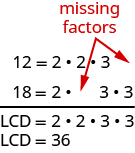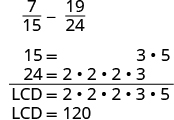| << Chapter < Page | Chapter >> Page > |
When finding the equivalent fractions needed to create the common denominators, there is a quick way to find the number we need to multiply both the numerator and denominator. This method works if we found the LCD by factoring into primes.
Look at the factors of the LCD and then at each column above those factors. The “missing” factors of each denominator are the numbers we need.

In [link] , the LCD, 36, has two factors of 2 and two factors of
The numerator 12 has two factors of 2 but only one of 3—so it is “missing” one 3—we multiply the numerator and denominator by 3.
The numerator 18 is missing one factor of 2—so we multiply the numerator and denominator by 2.
We will apply this method as we subtract the fractions in [link] .
Subtract:
Do the fractions have a common denominator? No, so we need to find the LCD.
Find the LCD.
 |
|
| Notice, 15 is “missing” three factors of 2 and 24 is “missing” the 5 from the factors of the LCD. So we multiply 8 in the first fraction and 5 in the second fraction to get the LCD. | |
| Rewrite as equivalent fractions with the LCD. |
 |
| Simplify. |
 |
| Subtract. | |
| Check to see if the answer can be simplified. | |
| Both 39 and 120 have a factor of 3. | |
| Simplify. |
In the next example, one of the fractions has a variable in its numerator. Notice that we do the same steps as when both numerators are numbers.
Add:
The fractions have different denominators.
 | ||
Find the LCD.
 |
||
| Rewrite as equivalent fractions with the LCD. |
 | |
| Simplify. |
 | |
| Add. |
 |
We now have all four operations for fractions. [link] summarizes fraction operations .
| Fraction Multiplication | Fraction Division |
|
Multiply the numerators and multiply the denominators |
Multiply the first fraction by the reciprocal of the second. |
| Fraction Addition | Fraction Subtraction |
|
Add the numerators and place the sum over the common denominator. |
Subtract the numerators and place the difference over the common denominator. |
| To multiply or divide fractions, an LCD is NOT needed.
To add or subtract fractions, an LCD is needed. |
Simplify: ⓐ ⓑ
First ask, “What is the operation?” Once we identify the operation that will determine whether we need a common denominator. Remember, we need a common denominator to add or subtract, but not to multiply or divide.
Notice we needed an LCD to add but not to multiply

Notification Switch
Would you like to follow the 'Elementary algebra' conversation and receive update notifications?